The LG X Power Review
by Brandon Chester on August 31, 2016 9:03 AM EST- Posted in
- Smartphones
- LG
- LG X Power
System Performance
As I mentioned on the first page, the LG X Power comes in two versions. The international model uses MediaTek's MT6735 SoC, which has four Cortex A53 cores with a peak frequency of 1.3GHz. The North American model uses Qualcomm's Snapdragon 212 SoC with four Cortex A7 cores that also reach a peak frequency of 1.3GHz. Depending on the workload, there can be a considerable performance difference between Cortex A7 and Cortex A53. I don't know why LG has opted to ship two models of the same phone with significantly different SoCs, and it would have made much more sense to use Snapdragon 410 in the North American market.
I don't have both models of the LG X Power available for review, so I can really only speak to the performance of the North American model. There will definitely be differences in CPU and GPU performance between the two, and it's also important to note that the international model has an additional 512MB of RAM. Since the LG X Power doesn't support OpenGL ES 3.1, I've cut some of the benchmarks from the standard group that I run. Below I've organized the remaining benchmarks into sections that represent what part of the system each benchmark tests.
App Performance
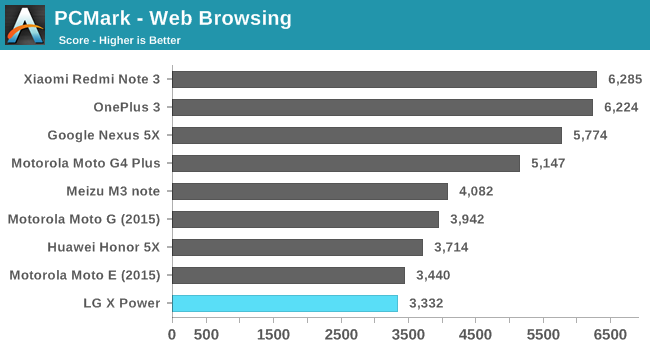
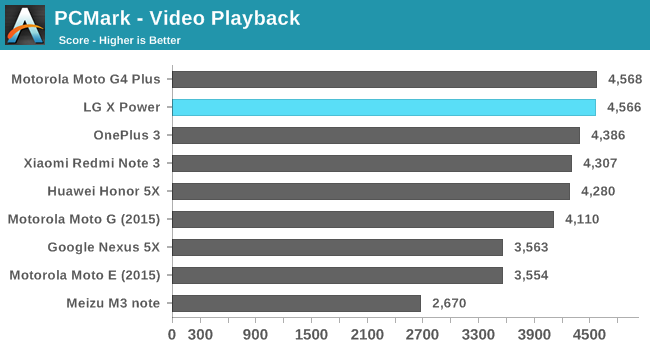
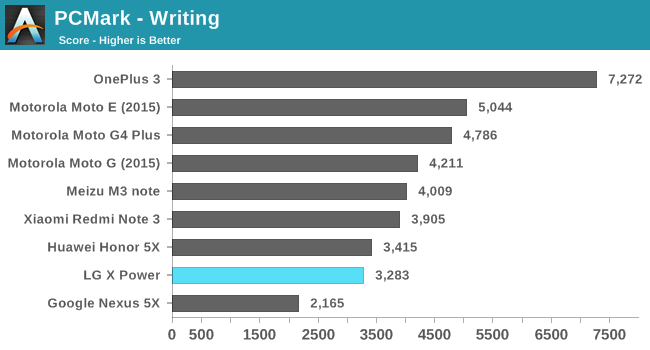
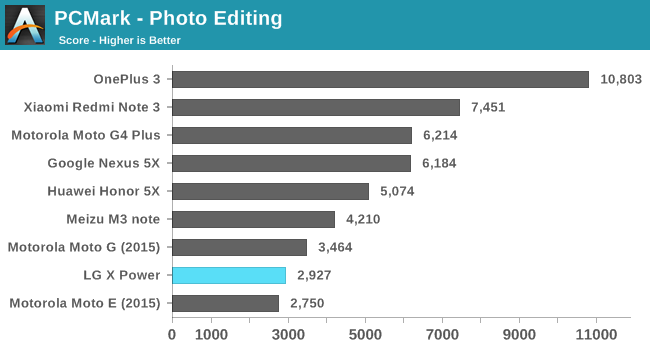
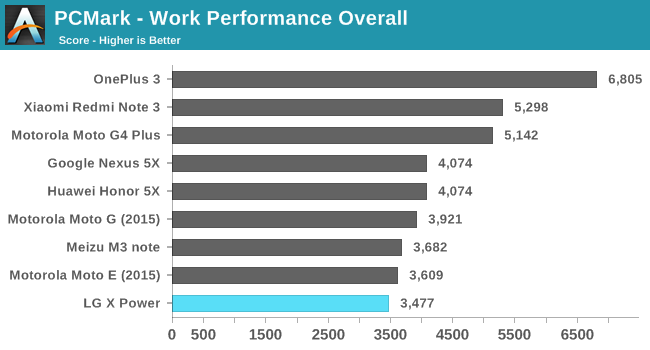
PCMark is a good benchmark because it simulates actions that users perform on a daily basis, and does so using the same system APIs as real applications. This makes it particularly sensitive to software optimizations, as well as changes in Android version that bring improvements to the Android API.
The LG X Power doesn't get off to a good start in PCMark. In every sub-test except the video playback test it is one of the slowest devices on record. While it doesn't come in very last in photo editing or writing, it's close enough that the devices it beats in those individual tests actually end up doing better when all the scores are aggregated, making the LG X Power the overall slowest device on record for PCMark.
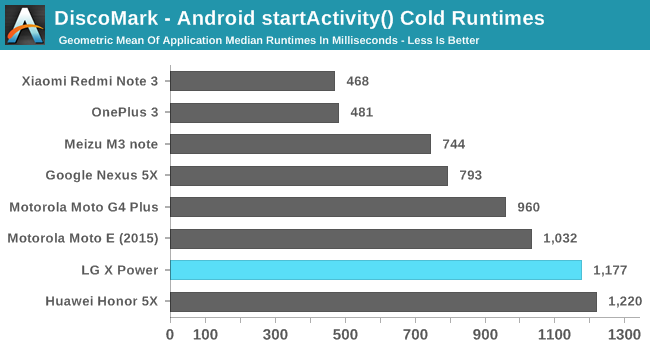
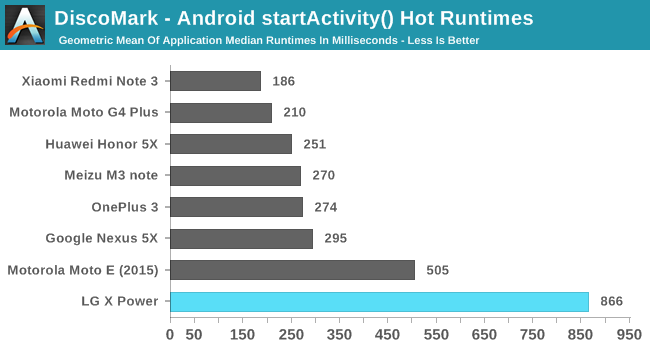
DiscoMark is a new addition to our benchmark suite. It allows us to measure the time it takes for an application to launch by monitoring how long it takes for an Activity to be created after a call to Android's startActivity method. For testing we have selected a group of commonly used applications, and the box-and-whisker diagrams allow the quickest and longest launch times for each app to be displayed, along with the first and third quartile boundaries. We also split the test into two parts, with the first being cold launches where an application has been killed before being launched, and hot launches where an application will still be resident in memory if the phone has enough RAM to accommodate it.
Unfortunately, DiscoMark shows how limiting the 1.5GB of RAM in the LG X Power is. In the cold launch test you're really limited by the speed of your SoC, and to an extent your NAND speed as things are read from persistent storage and loaded into memory. In this case the LG X Power is in line with Cortex A53 devices despite its use of a Cortex A7 CPU, which isn't a bad situation to be in.
The real issue for the LG X Power is the hot app launch times. The average median runtime for launching an app that could be resident in memory is 866ms, nearly twice as long as the next slowest phone, and three or four times slower than most other smartphones. It's apparent that LG is having to evict applications quite frequently, which means that although we aren't forcibly killing the apps, they're being re-created from scratch nonetheless. One interesting thing to note is that the Moto E (2015) performs much better despite having only 1GB of RAM, and this is probably a combination of LG's much heavier software customizations, along with different policies for memory management, data caching, and app eviction.
The impact that this has on the user experience is immense. It takes nearly a whole second to switch to an app that you would expect is still in memory, because it has often been evicted if you've opened only a couple other apps since you last used it. It makes the phone feel incredibly painful to use, to the point where you end up not using the phone because of how slow it is. With that in mind, the phone's large battery looks more like an insurance policy than a useful feature, because the phone will already last a long time by virtue of you choosing to avoid using it unless you absolutely need to.
Web Performance
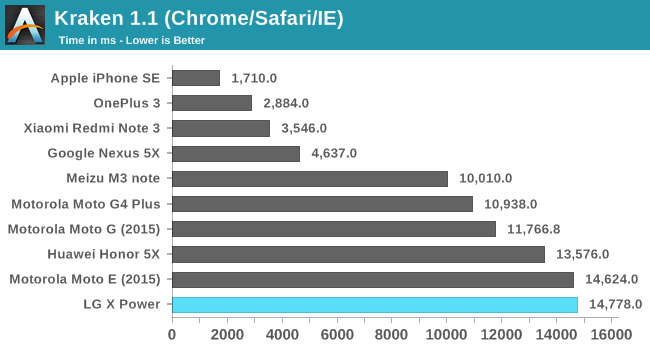

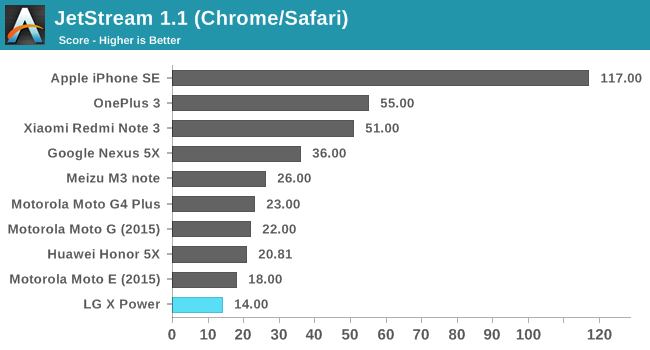
Unsurprisingly, the LG X Power is the slowest device in all three web benchmarks. A quad core Cortex A7 SoC is just not competitive at all, even against the Moto E from February 2015, which launched at a lower price than the LG X Power. I don't really have much else to say here, as the web browsing performance of the LG X Power is just terrible, and I find it shocking how LG has seemingly bet the entire phone on a giant battery and neglected performance entirely, to the detriment of the user experience.
Graphics Performance

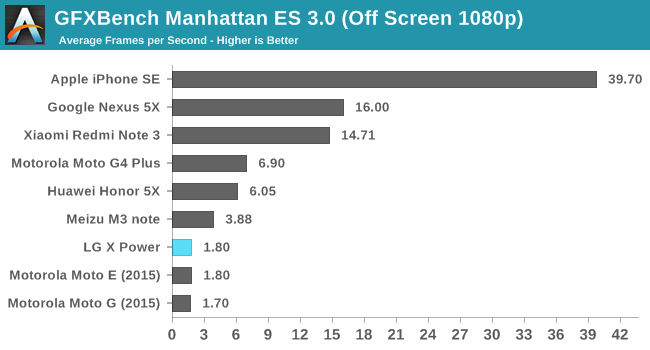
Adreno 304, 305, and 306 are essentially identical, so it's not a surprise to see that the LG X Power sits right beside devices that use Snapdragon 400 and 410 in GFXBench's Manhattan ES 3.0 graphics test. Low end smartphones just don't have great GPU performance, although it won't prevent simple 2D games from being played. I don't expect this to change any time soon for phones that cost close to $100, but I also doubt that it impacts the kind of user that purchases a $100 phone in any appreciable manner.
NAND Performance
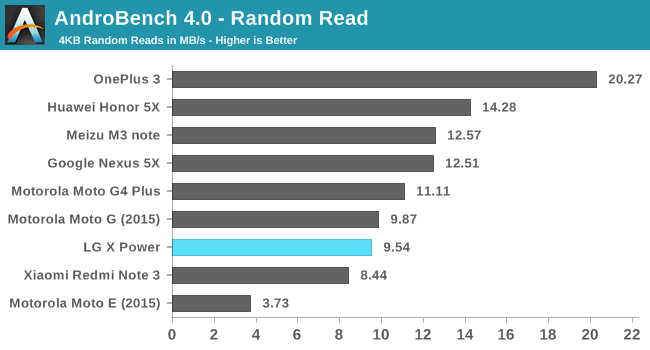
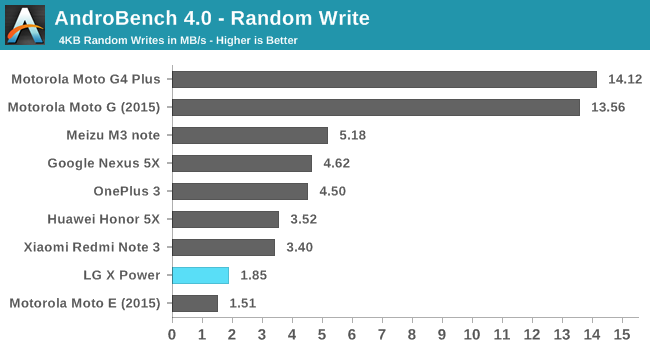
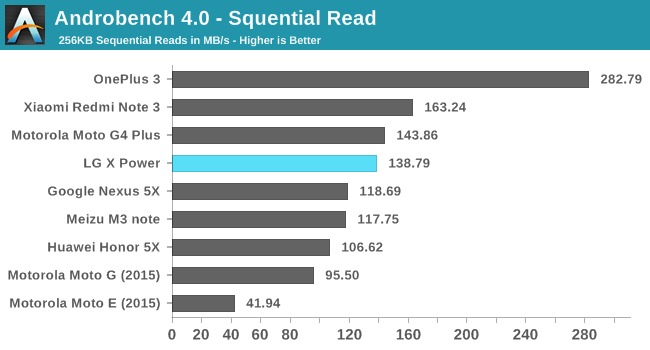
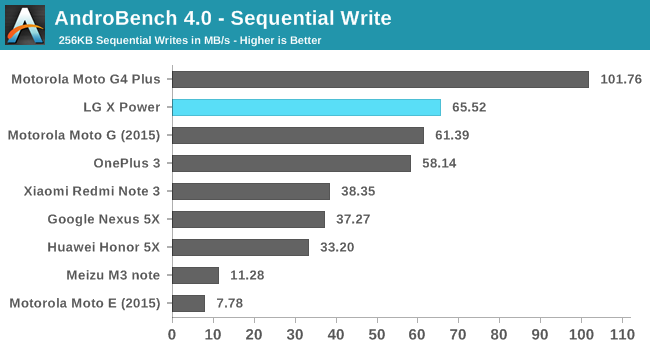
NAND performance on the LG X Power is actually decent as far as low-end smartphones go. Random read and write performance is definitely low, but sequential read and write performance is actually pretty good among the low-end and mid-range phones in the comparison. I don't expect that mid-range smartphones will move away from eMMC storage any time soon, so this is around the best storage performance that you'll see in a $100-150 smartphone.


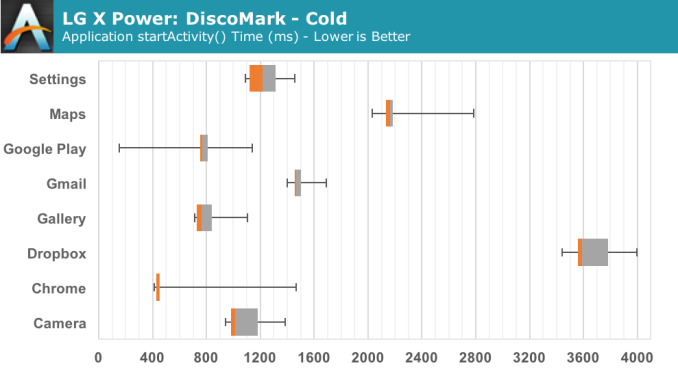
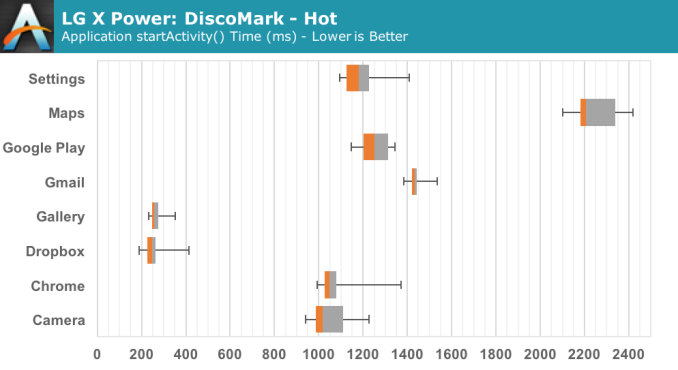








48 Comments
View All Comments
velanapontinha - Wednesday, August 31, 2016 - link
Why oh why do they release two phones with same brand and model and so many different specs?DanNeely - Wednesday, August 31, 2016 - link
MediaTek offers more bang for the buck; but doesn't have the CDMA support needed for the VZW/Sprint networks. At the low price this thing is selling for they can't afford a few extra dollars on the BOM without wiping out their entire margin on the device.Samus - Wednesday, August 31, 2016 - link
Yeah, it's annoying, but because of our carrier saturation in the USA we generally get unique versions (or two versions) of phones. This is one reason why Apple arranged with only one carrier for so many years, and many phones are carrier exclusives.There is nothing preventing you from importing the international version for T-mobile but the LTE bands don't line up so you will only get HSPA+ (which isn't a bad thing on T-mob) however, I'd be surprised if the performance difference between these two models is even relevant, both SoC's are bottom barrel and will be outperformed by SoC's from years ago. The .5GB difference is probably more relevant, and both camera sensors suck so the pixel difference is a wash.
psyside1 - Wednesday, August 31, 2016 - link
Opens article.See MT6753
Close article.
WPX00 - Friday, September 2, 2016 - link
It's not even MT6753. The 53 is an octa-core chip. This is the MT6735 with a quad-core chip.okp11 - Tuesday, October 4, 2016 - link
Based off of the LG and Sprint site it looks like this is a completely different phone then what is listed for sale by them.The Sprint site lists the X Power as an LS755, which has a MediaTek 1.8 GHz Octa-Core MT6755M and 2GB of RAM.
The LG site also has a spec sheet for the Cricket and U.S. Cellular versions of the phones under the names K450 and US610. These both use quad core Snapdragon processors and 1.5GB of RAM...So it appears that almost everything negative about this phone is only applicable to those carriers, not Sprint or Boost's versions.
Very disappointed that none of this was mentioned anywhere in the review, as I'm sure the largest market for this phone will be people on Sprint, which is offering a vastly different set of specs under the same moniker.
jgarcows - Wednesday, August 31, 2016 - link
Thank you for reviewing a sub-$200 phone. They aren't as flashy, but this is the price point a lot of us want to shop at. Please do more reviews like this. I would be especially interested in some handsets with smaller screens.Teknobug - Wednesday, August 31, 2016 - link
Wow all the hardware skimped out but has a huge 4100mAh battery? Most top end phones barely has a 2800mAh.zeeBomb - Wednesday, August 31, 2016 - link
The NA version is a slap in the face tho. You're getting smartwatch power/Cortex A7 on a device like this where a 410 would be just as good as the mediatek version...okay display for a budget phone but sluggish performance. If it wasn't for the battery, this phone would easily be forgotten. Also the call quality is pretty abysmal too.DanNeely - Wednesday, August 31, 2016 - link
"Unfortunately, I think LG's strategy has really missed the mark. Consumers definitely do value some things more than others in smartphones, but just by looking at LG's smartphones you can see that they sacrifice the quality of other aspects to focus on a single feature. No consumer wants a phone that only does one thing well, they just have priorities about what a phone should do best. In that situation, a phone that tries to provide a good all-around experience is going to win every time,"Potentially I see this as a valid strategy; but at a slightly higher pricepoint. Instead of adding a single halo feature to a phone that does everything badly to hit an ultralow pricepoint, use something like the Moto G - which does everything adequately - and add the halo feature to that instead.